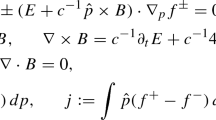Abstract
In the present work, a numerical modified Verlet scheme (MVS) is obtained. This scheme is intended to solve the equations of motion of charged particles immersed in an external stationary environment and a uniform magnetic field, for example, charged particles of a condensed substance in a buffer plasma (dusty plasma). The influence of the environment on the particle dynamics is described by the friction force. The particle dynamics are also affected by interparticle interaction and an external uniform magnetic field. To obtain the Verlet scheme (VS), the coordinates and velocities of the particles are decomposed into a Taylor series, taking into account the Lorentz force and the friction force. All Taylor series expansion terms that give the same order of accuracy are taken into account. In the obtained numerical scheme, the time step of modeling does not depend on the magnitude of the magnetic field but is determined only by the internal physical properties of the system under consideration, which is important when modeling an ensemble of charged particles taking electromagnetic fields into account. The paper solves a test problem for which particle trajectories obtained based on the conventional and modified VS for different values, both the friction parameter and the magnetic field parameter, are compared. Based on the analysis of the dependence of the maximum relative deviation of the coordinate on the time step, the time step is independent of the magnetic field in the Taylor expansion scheme, while in the inverse VS it is dependent.




Similar content being viewed by others
REFERENCES
V. E. Fortov, A. V. Ivlev, S. A. Khrapak, A. G. Khrapak, and G. E. Morfill, “Complex (dusty) plasmas: Current status, open issues, perspectives,” Phys. Rep. 421, 1 (2005).
V. E. Fortov and G. E. Morfill, Complex and Dusty Plasmas: From Laboratory to Space (CRC Press, Boca Raton, FL, 2009).
E. Bonnetier, L. Jakabčin, S. Labbé, and A. Replumaz, “Numerical simulation of a class of models that combine several mechanisms of dissipation: Fracture, plasticity, viscous dissipation,” J. Comp. Phys. 271, 397 (2014).
T. Ott, M. Bonitz, P. Hartmann, and Z. Donko, “Effect of correlations on heat transport in a magnetized strongly coupled plasma,” Phys. Rev. E 83, 046403 (2011).
T. Ott, H. Loewen, and M. Bonitz, “Magnetic field blocks two-dimensional crystallization in strongly coupled plasmas,” Phys. Rev. Lett. 111, 065001 (2013).
G. Uchida, U. Konopka, and G. Morfill, “Wave dispersion relation of two-dimensional plasma crystals in a magnetic field,” Phys. Rev. Lett. 93, 155002 (2004).
T. Ott, H. Loewen, and M. Bonitz, “Dynamics of two-dimensional one-component and binary Yukawa systems in a magnetic field,” Phys. Rev. E 89, 013105 (2014).
F. B. Baimbetov, T. S. Ramazanov, K. N. Dzhumagulova, E. R. Kadyrsizov, O. F. Petrov and A. V. Gavrikov, “Modelling of dusty plasma properties by computer simulation methods,” J. Phys. Math. Gen. 39, 4521–4525 (2006).
K. N. Dzhumagulova, T. S. Ramazanov, Y. A. Ussenov, M. K. Dosbolayev, and R. U. Masheyeva, “Study of the dustfree region near an electric probe and the dust particles oscillations in dusty plasma,” Contrib. Plasma Phys. 53, 419 (2013).
K. N. Dzhumagulova, T. S. Ramazanov, and R. U. Masheyeva, “Velocity autocorrelation functions and diffusion coefficient of dusty component in complex plasmas,” Contrib. Plasma Phys. 52, 182 (2012).
K. N. Dzhumagulova, T. S. Ramazanov, and R. U. Masheyeva, “Diffusion coefficient of three-dimensional Yukawa liquids,” Phys. Plasmas 20, 113702 (2013).
Q. Spreiter and M. Walter, “Classical molecular dynamics simulation with the Velocity Verlet algorithm at strong external magnetic fields,” J. Comput. Phys. 152, 102 (1999).
K. N. Dzhumagulova, R. U. Masheyeva, T. S. Ramazanov, and Z. Donko, “Effect of magnetic field on the velocity autocorrelation and the caging of particles in two-dimensional Yukawa liquids,” Phys. Rev. E 89, 033104 (2014).
T. Ott, M. Bonitz, and Z. Donkò, “Effect of correlations on heat transport in a magnetized strongly coupled plasma,” Phys. Rev. E 92, 063105 (2015).
M. Bonitz, Z. Donkò, T. Ott, H. Kahlert, and P. Hartmann, “Nonlinear magnetoplasmons in strongly coupled Yukawa plasmas,” Phys. Rev. Lett. 105, 055002 (2010).
Funding
The study was carried out as part of grant AP05132665 of the Ministry of Education and Science of the Republic of Kazakhstan.
Author information
Authors and Affiliations
Corresponding author
Ethics declarations
The authors declare that they have no conflicts of interest.
Rights and permissions
About this article
Cite this article
Dzhumagulova, K.N., Ramazanov, T.S., Masheyeva, R.U. et al. Model for Investigating the Physical Properties of a System of Charged Particles Taking into Account the External Magnetic Field and Friction Force. Math Models Comput Simul 12, 528–535 (2020). https://doi.org/10.1134/S2070048220040079
Received:
Revised:
Accepted:
Published:
Issue Date:
DOI: https://doi.org/10.1134/S2070048220040079




